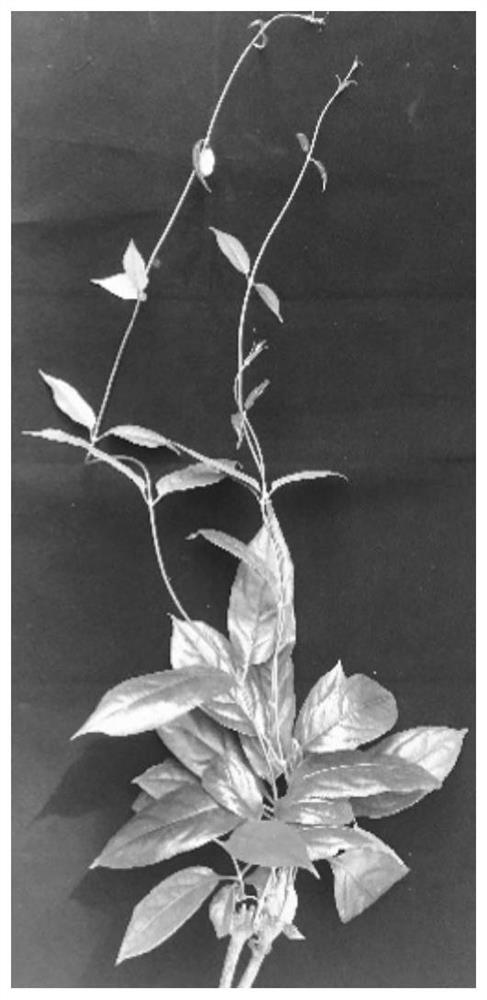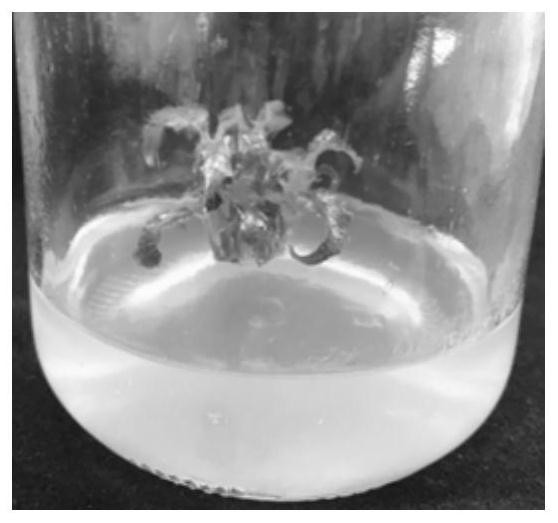Morinda officinalis tissue culture method
A technology of tissue culture and Morinda officinalis, applied in horticultural methods, botanical equipment and methods, horticulture, etc., can solve problems such as poor genetic stability, easy variation, and quality decline, and achieve good genetic stability, no Easy to mutate and maintain the effect of medicinal properties
- Summary
- Abstract
- Description
- Claims
- Application Information
AI Technical Summary
Problems solved by technology
Method used
Image
Examples
Embodiment 1
[0055] The detoxified and cleaned Morinda officinalis cane is used as explants, specifically, the explants are semi-lignified stem segments.
[0056] The explants were inoculated in the axillary bud induction medium, illuminated for 11 hours every day, the daily light intensity was 1300lx, the air temperature was 28°C, and the humidity was 75%. After 30 days of cultivation, the axillary buds grew. Among them, the axillary bud induction medium is 1 / 2MS+6-BA0.2mg / L+30g / L sucrose+4.3g / L agar powder, and the pH is 6.0.
[0057] The axillary buds were inoculated on the cluster bud induction medium, illuminated for 13 hours every day, the intensity of light every day was 1200 lx, the air temperature was 28° C., and the humidity was 75%. After 30 days of cultivation, the cluster buds grew. Wherein, the cluster bud induction medium is 1 / 2MS+6-BA0.2mg / L+30g / L sucrose+4.3g / L agar powder, and the pH is 6.0.
[0058] The cluster buds were inoculated on the rooting induction medium, illum...
Embodiment 2
[0060] For explant pretreatment, select adult 3-4-year-old Morinda officinalis, transplant it into a clean greenhouse, cut off the cane from the stem base of Morinda officinalis, and spray Morinda officinalis at a mass concentration of 10 every 7 days. % carbendazim solution, a new cane grows after one month as explant material.
[0061] The explants are disinfected and cleaned; the explants include young part, semi-lignified stem segment and fully lignified stem segment.
[0062] The explants were inoculated on the axillary bud induction medium, illuminated for 12 hours every day, the daily light intensity was 1200 lx, the air temperature was 28° C., and the humidity was 75%. After 30 days of cultivation, the axillary buds grew. Among them, the axillary bud induction medium is 1 / 2MS+6-BA0.2mg / L+30g / L sucrose+4.3g / L agar powder, and the pH is 6.0.
[0063] The axillary buds were inoculated on the bud-clump induction medium, illuminated for 12 hours every day, the intensity of...
Embodiment 3
[0066] For explant pretreatment, select adult 3-4-year-old Morinda officinalis, transplant it into a clean greenhouse, cut off the cane from the stem base of Morinda officinalis, and spray Morinda officinalis at a mass concentration of 10 every 7 days. % carbendazim solution, grow new cane after one month as explant material (such as figure 1 shown).
[0067] The newly grown cane explant material is placed on the ultra-clean workbench, the surface of the explant material is wiped with 75% alcohol, and cut into stem segments with a length of 2-3cm with nodes, wherein, cut Include the young tender stem section within 20cm from the top, the semi-lignified stem section approximately 20-40cm away from the top and the fully lignified stem section approximately more than 40cm from the top in the divided stem section. Disinfect young stems with 0.1% mercuric chloride solution for 4min30s, and sterilize semi-lignified and fully lignified stems with 0.1% mercuric chloride solution for ...
PUM
 Login to View More
Login to View More Abstract
Description
Claims
Application Information
 Login to View More
Login to View More - R&D
- Intellectual Property
- Life Sciences
- Materials
- Tech Scout
- Unparalleled Data Quality
- Higher Quality Content
- 60% Fewer Hallucinations
Browse by: Latest US Patents, China's latest patents, Technical Efficacy Thesaurus, Application Domain, Technology Topic, Popular Technical Reports.
© 2025 PatSnap. All rights reserved.Legal|Privacy policy|Modern Slavery Act Transparency Statement|Sitemap|About US| Contact US: help@patsnap.com



